

International Speed Bowl
The Nation's Site of Excitement
CLICK HERE TO GO TO THE THUNDER ROAD MOMENTS PAGE
ALWAYS - UNDER
 CONSTRUCTION
CONSTRUCTION
| Early Coupe Era | NASCAR Coupe Era | Original Flying Tigers Era | Early Late Model Sportsman Era | Hurricane Era | Grand American Era |
Mini Stock and Mini Modified Era |
The Kalomiris Era |
| Beer Tour Late Model Era | Early ACT Era |
Original Street Stocks |
Era New Tigers Era |
Thunder Road was the concept and
creation of Ken Squier, a successful local radio station owner, a very
experienced racing announcer despite his young age, and a nationally -
recognized sports announcer. Along with partners, the Cooley Brothers of
Barre, Squier found the perfect spot for Thunder Road International
Speedbowl, and nestled it into the existing terrain on a plot of land on
Quarry Hill in Barre, near Graniteville.
The track was state-of-the-art
for its day, despite its fairly unusual layout. As go-carts were the
rage of the day in 1960, the track, which was paved, featured a road
course - style go-cart track in the infield. The crowd had the option of
either sitting on stands built into the side of a hill, or literally sit
on the hill. It became known right away, that one particular section of
the hill was populated by the beer drinkers. Barre citizens, already
familiar with tracks in Waterford and Northfield, became immediate,
lifelong, loyal supporters of the track.
Things were going very smoothly at Thunder Road by the mid - '60's. The
huge fields included a healthy contingent of New Hampshire drivers, many
of whom had come from the Elms Family - operated Northeastern Speedway
in Waterford: the wild Ingerson brothers, Roy "Pappy"Forsyth,
Ronnie Marvin, Stanley "Stub" Fadden, Hank Montandon, and more
crossed the Eastern border to run against Vermonters like Chester T.
Wood, John Gammell, Tony Colucchio, etc.
Photo by Cho Lee
Roy
"Pappy" Forsyth, with the legendary George Barber 46, was one
of
Thunder Road's first superstars.
Superstars like Marvin, the Ingersons, and Forsythe were well and good, but the heart and soul of Thunder Road was that core of small - time local drivers like Leon Hayford, from nearby Graniteville, and Mike Osborne of Barre. This is the way things went for five years of Thunder Road's life. Northeastern and Dog River Speedways closed, Bear Ridge had not opened, and T Road was the only show around. While clearly being populated by very down-to-Earth people, it did project a modern image, with weekly races even having their own radio network, as Ken Squier owned WDEV radio, in Waterbury.

Courtesy of Cho Lee
Guys like Leon Hayford were the heart and soul.
COUPE ERA
CLICK HERE FOR MORE PHOTOS FROM THE EARLY COUPE ERA
Somebody decided that was time for expansion .... expansion into the state's most highly - populated county, Chittenden County. And they did - in the northern Chittenden County town of Milton. Catamount Stadium was born. However, for many years to come, Thunder Road remained the more stable and better- attended track in the family. While Catamount struggled with small fields and inconsistent attendance, T-Road was the anchor. Eventually. Thunder Road began mixing its familiar flathead cars with the NASCAR overhead V-8's. It wasn't popular with the Barre fans. Finally, the flatheads winning became a rarity.
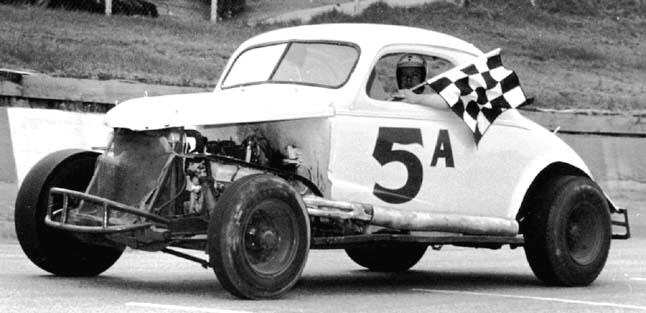
Courtesy of Cho Lee
Beloeil,
Quebec's Jean-Paul Cabana was the first
successful V-8 competitor at the Barre oval.
He had
competed on the track with a flathead, as well - but
with a local car owner.
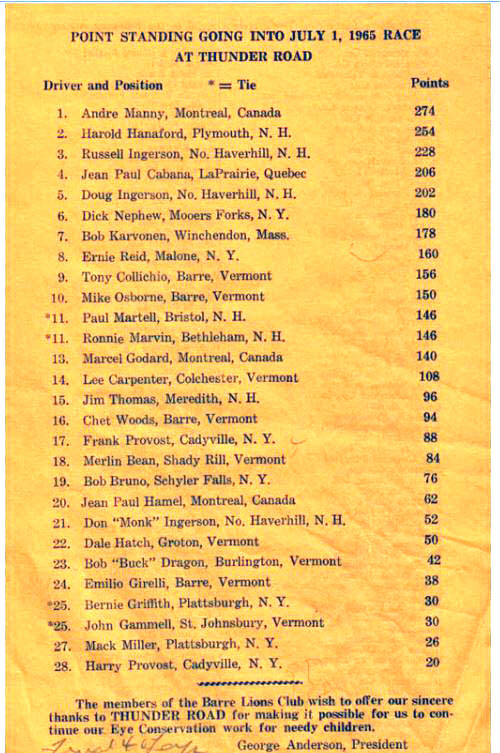
Courtesy of Andy Boright
This 1965 points list shows the unique
mixture that was Thunder Road. Manny, Cabana, Nephew, Karvonen, and Reid had
overhead V-8 cars;
Hanford, the Ingersons, and Colicchio had the traditinal flatheads. Marvin would
finish remarkably high in the NASCAR National Sportsman
point standings that year by campaigning in many locations with what I assume
was a flathead.
Here is a look at a few aspects of Catamount's parent track:
Thunder Road was a steeply - banked quarter mile paved speedbowl
Thunder Road could draw more fans on a Thursday night than Catamount could on Saturday night, in the mid-1960's
Many of the Chittenden County drivers, especially Flying Tiger drivers, began to associate themselves more with Catamount; this fostered a sometimes fairly dicey rivalry with the older, more established T-Road stars like Marvin, the Ingersons, and Fadden.
The beloved flathead Fords were grandfathered in for one more season at both tracks by NASCAR. NASCAR had outlawed the pre - 1936 bodies a few years before at all their tracks, and encompassed most of the original Thunder Road fields. This had little effect on Catamount but altered the very fabric of Thunder Road
Between 1966 and 1968, the racing eventually moved around to only the
Flying Tiger division
at both tracks. In the case of Thunder Road, about half of its Tiger fields were
made up of former flathead drivers, while a good corps of locals were also
developing. Many cars also came from Catamount.
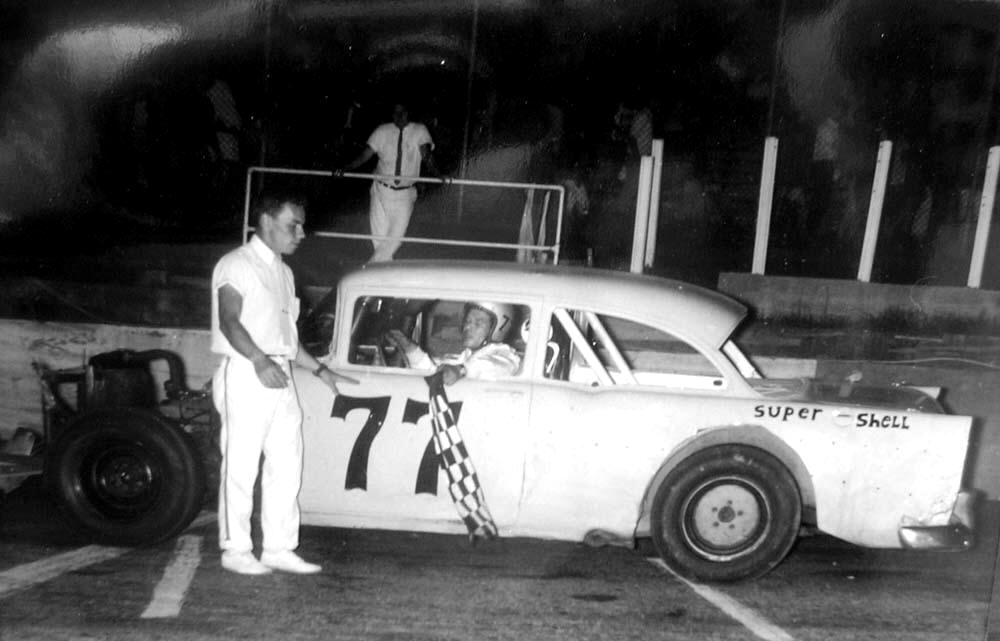
Courtesy of Cho Lee
1968 Thunder Road
champ Tom Tiller returns checkers to Bob Quinn as Jack Paradee [who once droive
a Tiger at T Road himself] looks on.
ORIGINAL FLYING TIGERS
From NASCAR Record Book
These 1968 standings still show the
regionalism that disappeared as teams began to travel more. Catamount's Dragon
brothers apparently spent little time
at Thunder Road. Barcomb and Tiller,
however, were already makking the full circuit effort by then.
Eventually, management tried switching the evenings that the two tracks operated. but Catamount did not really catch on until it dropped the sportsman and modifieds and worked only with local late model drivers. Thunder Road followed suit. By then, the traditional flat-topped coupes were gone, and many of the older drivers had grabbed themselves a Flying Tiger car and joined the fray.
Sometimes, the T-Road drivers and the Catamount regulars would be bonded together in a mutual dislike of the big dollar Canadians who began to filter back - especially to Catamount : Jean-Paul Cabana, Andre Manny, and Claude Aubin - to name a few. The circuit had upgraded first, to limited sportsman and - later - full - fledged late model sportsman cars. This began to attract the Canadians, as well as teams from all over New England.
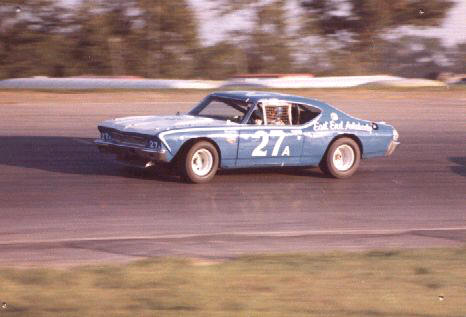
Bob Doyle Photo - Ladabouche Collection
Andre Manny, in the
immaculate Gaston Ethier 27A was typical of the well-financed Canadian invasion
of the early 1970's.
EARLY LATE MODEL SPORTSMAN
T-Road would go on to work in perfect concert with Catamount - and with a host of other tracks which whom the management of the two tracks would form temporary arrangements over the course of the next decades: Devil's Bowl, Airborne, Sanair, Oxford, and others. By 1972 and 3, the teams found themselves racing several nights a week - strangely reminiscent of the very early days of stock car racing.
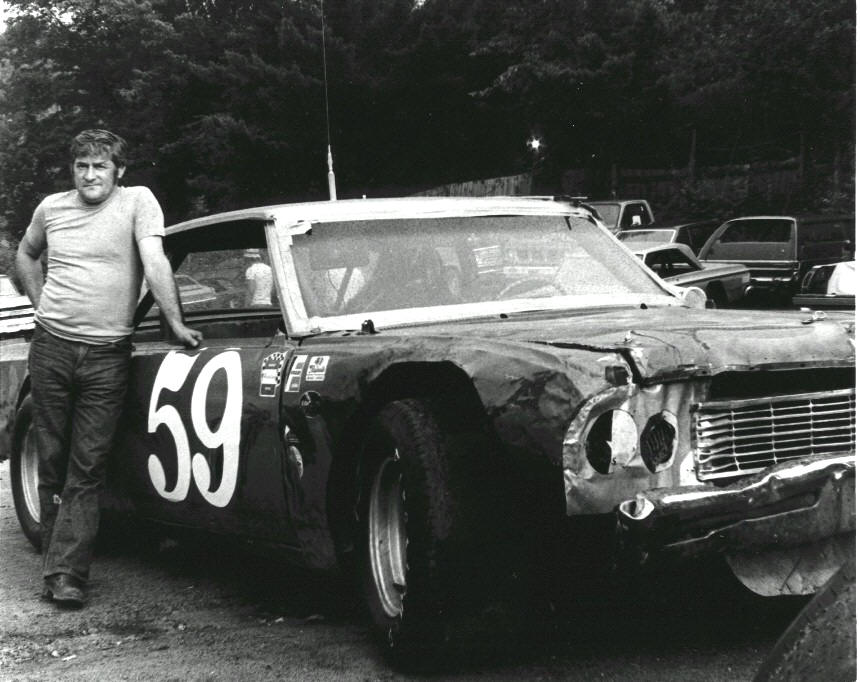
Photo by Bob Doyle - Ladabouche Collection
Fairfax, Vermont's
Hector LeClair, though well sponsored, shows the strain of the intense
schedule almost as much as does his Chevelle.
The track
management had the foresight to install a support division to replace when the
Flying Tigers had become the whole show in 1968. By 1970, they had the automatic
transmission, totally - stock Hurricane Division which developed future stars
like Jamie Aube, Richard Buzzi, and Darrell Owens. The true measure of how far
they came was when you could watch an entrie field fo Hurricanes go through a
corner and hear no tire squeal. Even today's Tigers can't mange that.
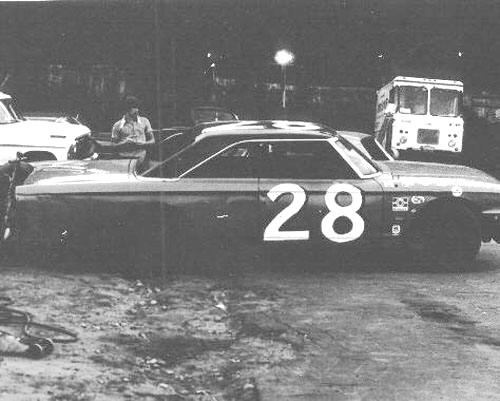
Photo Courtesy of Cho Lee
Dennis Tucker, Washington, VT was one of the local boys who
started in the Hurricane Division at Thunder Road.
HURRICANE
The Hurricanes were evolved into six cylinder pony cars like Camaros and Mustangs - probably because they had more appeal. The new
division was called The Grand Americans. Within a year, those cars could
corner as effortlessly as the late models. Several of the competitors from
this short-lived division would go on to participate in the late models -
or the next version of the Flying Tigers, which came about in the 1980's.
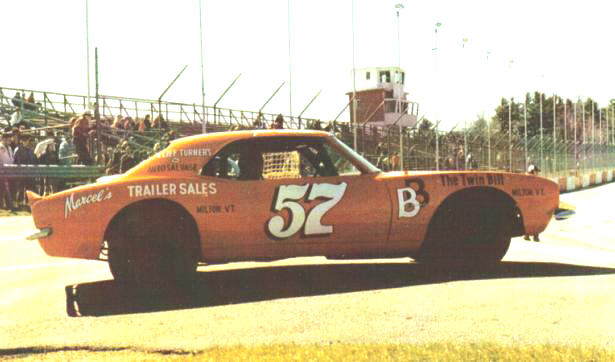
Photo Courtesy of Lonnie Terry
The Hurricane
support division evolved into the nifty, well-handling six cylinder Grand
American Division by 1980.
Those cars especially loved the T-Road quarter
mile. This is Milton, Vermont's Jim Barton.
GRAND AMERICAN
MINI STOCKS AND MINI MODS
Courtesy of Cho Lee
Mike Richmond and Chris Ford [or
possibly Mark Rossi], at
speed at Thunder Road.
As the fortunes of the late models and their touring system seemed to hit
an all-time high, a major disaster struck Thunder Road, and - therefore -
the whole city of Barre. For some reason, the management inexplicably
decided to sell the track to a man from Long Island, New York named Tommy
Kalomiris. Kalomiris, an avowed lover of the track and its activities had
big plans to make great improvements to the facility. All of this started
to fall apart in his first season of operation, and, before long, financial
problems were piling up. The track was padlocked and Kalomiris went back to the
New York area - apparently making calls to Vermont from a pay phone at times. He
refused to release the track so that it could be re-opened.
Photographer Unknown
Stanley "Stub" Fadden is as picture
of patient sklepticism as he stands with short - lived
track owner Anastasios
"Tommy" Kalomiris". Fadden, who won
two races at T Road in the Kalomiris era.
THE KALOMIRIS ERA
Furious locals began to vent their frustrations with Kalomiris on the
property itself. The once-famous lights were destroyed, building were
knocked down, and various other forms of vandalism erupted on the track.
Eventually, Tom Curley, Ken Squier, and others regained control and it
took months of work and legions of volunteer help to put the facility back
in usable shape. Bear Ridge Speedway had to lend their lighting system, at
one point. No one is too sure . The circuit really flourished, and became
NASCAR North, a tour series supported by beer companies.

Courtesy of L.A.West
Thunder Road was now fielding very sophisticated, state - of - the - art
late model sportsman cars - until the split with NASCAR
in the 1980's.
THE BEER TOUR ERA

Courtesy of Mr. Chevy Black
The next event to have a strong effect on the fortunes of Thunder Road
International Speedbowl was the untimely demise of sister track, Catamount
Stadium in Milton. Built on what was reportedly leased land, the track could no
longer obtain a lease extension and it closed in the late 1980's. By 1986,
NASCAR had been dropped and - by 19787 - the American - Canadian Tour was
beginning what woould be a decades - long relationship with the track. Now
T-Road was the flagship of the American - Canadian Tour. It continues to carry
this banner to this day. The track has enjoyed several wonderful modernizing
improvements and considerable expansion [and needs more modernizing].
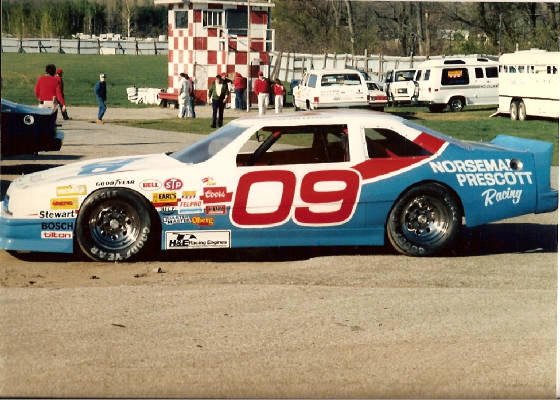
Courtesy of Mike Cain
Kevin LePage piloted the heavily - sponsored
E J Prescott car before being replaced by Ricky Craven.
After ACT was ensconced at Thunder Road, the recently - developed New Flying
Tigers [a division arisen from the former Grand American and Street Stock
classes] became the main division, seeing as the late models were touring. This
has led, over the past decades to today's late model, Tiger, and four cylinder
Street Stock classes.
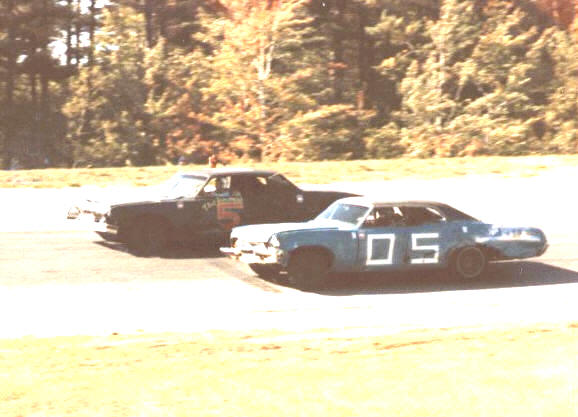
Blow Family Collection
Ron Blow, in the 05, battles Al
Simoneau in one of the few Thunder Road Street Stock shots of this era.
THE ORIGINAL STREET STOCKS
After ACT was ensconced at Thunder Road, the recently - developed New Flying
Tigers [a division arisen from the former Grand American and Street Stock
classes] became the main division, seeing as the late models were touring. This
has led, over the past decades to today's late model, Tiger, and four cylinder
Street Stock classes.
A and A Ward Photos
The "New Tigers"
race at Thunder Road around 1985. The class was a mix of old Grand
American cars [see 90 Ralph Baldwin, 1A Fuzzy Fassett, 97, Dave Gibbs]
and former Street Stock cars
[see Jim Payea's 89 and that Oldsmobile
at bottom]. There were beginning to be specially - built
New Tigers cars
as shown below: Chuck Beede [54] and Clem Despault. Below - More action
- same day.
THE NEW FLYING TIGERS
 Bob Mackey Photo Courtesy of John Rock A mixed lineup of flathead coupes and the newer overhead sportsman coupes - from 1965. |
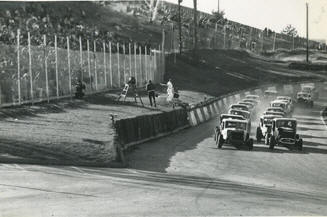 Bob Mackey Photo Courtesy of John Rock A mixed lineup of flathead coupes and the newer overhead sportsman coupes get the green. |
|
Bob Mackey Photo Courtesy of John Rock A lineup of the newer overhead sportsman coupes - from 1965. |
Bob Mackey Photo Courtesy of John Rock A heat of midgets mix it up on turn one. |
|
Courtesy of Cho Lee A spinout in the coupe era. [Same as above] |
Courtesy of Cho Lee The aftermath of the spinout. ? is Dale Hatch and the 93 is the Libero Buzzi car driven by Tony Collicchio. |
Courtesy of Jim Ladabouche
Joe was a well - known Rutland, VT area sports
personality.
Courtesy of Jim Watson
1972. A feature starting field,
looking East. John Untied is on the track.
Courtesy of Jim Watson
The same field, looking West,
with Barton's Jerry Young on the pole.
ACT Archives Courtesy of Cho Lee
A much younger Tom Curley, with
Archie Blackadar and Lennie
Stockwell - when Lennie was an official.

Terraserver USGS Photo
Thunder Road in the
1990's - from satellite. The stands and front
stretch are to the bottom of the photo.
Return to the Main Page
Return to the
Main News Page
Return
to the All Links Page